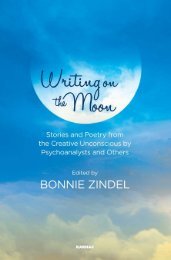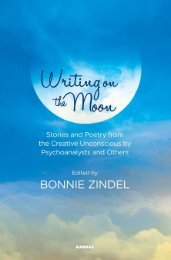Sample Book
You also want an ePaper? Increase the reach of your titles
YUMPU automatically turns print PDFs into web optimized ePapers that Google loves.
WRITING ON THE MOON
WRITING ON THE MOON<br />
Stories and Poetry from the<br />
Creative Unconscious by<br />
Psychoanalysts and Others<br />
Edited by<br />
Bonnie Zindel
For David and Lizabeth<br />
and<br />
In Memory of Mannie Ghent
CONTENTS<br />
ACKNOWLEDGEMENTS<br />
ABOUT THE EDITOR<br />
INTRODUCTION<br />
ix<br />
xiii<br />
xv<br />
CHAPTER ONE<br />
Dreams as poetry 1<br />
CHAPTER TWO<br />
From image to words: one unconscious speaks to another 12<br />
CHAPTER THREE<br />
Love calls: a call for love 30<br />
CHAPTER FOUR<br />
Creativity and madness 44<br />
CHAPTER FIVE<br />
The art of Thomas Ogden 52<br />
vii
viii<br />
CONTENTS<br />
CHAPTER SIX<br />
Letters to Dearest Mother from famous writers 59<br />
CHAPTER SEVEN<br />
Poetry by people in analysis 72<br />
CHAPTER EIGHT<br />
Voices out of New Orleans: Hurricane Katrina 88<br />
CHAPTER NINE<br />
Presence and absence 95<br />
CHAPTER TEN<br />
Emotional travel writing 107<br />
CHAPTER ELEVEN<br />
The unexpected poet: D. W. Winnicott 117<br />
CHAPTER TWELVE<br />
Mothers of the Milky Way 125<br />
Part One: poetry<br />
CHAPTER THIRTEEN<br />
Mothers of the Milky Way 137<br />
Part Two: creative nonfiction<br />
CHAPTER FOURTEEN<br />
Art brut—outsider art 154<br />
CHAPTER FIFTEEN<br />
Strong women’s voices 166<br />
CHAPTER SIXTEEN<br />
Capturing moments: four very, very short narratives,<br />
three poems, and a photograph 181<br />
CHAPTER SEVENTEEN<br />
Ferenczi and relationality: on losing one’s analyst 195<br />
INDEX 209
ACKNOWLEDGEMENTS<br />
Many thanks to the editors of Psychoanalytic Perspectives, who have<br />
supported my vision and given me the space to create something<br />
new in a scholarly journal. I also want to express deep appreciation<br />
for the extraordinary education and clinical training I received at my<br />
professional home, the National Institute for the Psychotherapies in<br />
New York—and to all my friends and colleagues in the NIP community.<br />
I’m extremely grateful to Rod Tweedy, my editor at Karnac, for<br />
believing in this book and bringing his gifted hands to the project.<br />
Thanks also to Kate Pearce, Cecily Blench, Constance Govindin, and<br />
James Darley at Karnac, who all made important contributions.<br />
I’m indebted to Amanda Ashworth, publisher of Psychoanalytic Perspectives<br />
at Routledge, for her creative enthusiasm and for sharing her<br />
love of Wordsworth—and to production editor Leah Cutler, who has<br />
been a steady and meticulous hand.<br />
To Mannie Ghent, my training analyst, who encouraged my rebirth,<br />
and who read to me from treasured books in his library, especially the<br />
poems of Jacques Prevert and Ovid’s Metamorphosis.<br />
I am especially grateful to Thomas Ogden, who embodies the essence<br />
of creative vitality. We share a love of literature and writing. He has<br />
been a trusted source of inspiration, and I deeply value our friendship.<br />
ix
x<br />
ACKNOWLEDGEMENTS<br />
To Spyros Orfanos, who exudes the spirit of Zorba the Greek, for his<br />
innovative creativity study group—and to my fellow creative travelers.<br />
To Jody Davies, and the gifted women in our study/supervision group,<br />
for their intuition and generosity.<br />
I also wish to thank Julie Grenet, not only a psychoanalyst but also<br />
a French scholar, who translated the letters of Proust, Flaubert, and<br />
George Sand. And thanks to Allison Katz for her generous assistance.<br />
Special appreciation to my patients and supervisees, who have<br />
enriched my life more than they know.<br />
Many thanks also to the members of the creative writing groups I<br />
have run over the past twenty years. I am in awe of the risks they take<br />
every time they write.<br />
Heartfelt thanks to my dear friends through the years for their love,<br />
friendship, and hours of soul-searching and laughter: Nancy Spanier,<br />
my creative co-conspirator since we were thirteen years old, Janine de<br />
Peyer, Ida Dancyger, Ellen Fries, Caryn Sherman-Meyer, Joyce Selter,<br />
Puja Hall, Judith Lit, Pam Frost, Renee Hertzberg, and Constance Cohen.<br />
And to my family. My caring father who always loved me for just<br />
being me; he taught me to value my mind and instilled the importance<br />
of lifelong intellectual curiosity. And to my mother who encouraged me<br />
to dream in many important ways. And to my late big brother, Vic, who<br />
is dearly missed.<br />
I feel immense indebtedness to my late husband Paul Zindel for<br />
encouraging me to be a writer, and for his brilliant appreciation of<br />
drama and language. He was the ultimate artist, and the best person<br />
at surprises and the unexpected. He gave freely of his knowledge and<br />
talent, and I am eternally grateful.<br />
To my son David, whose adventurous spirit and playful sense of<br />
humor have always made me smile and see the world in a new way. To<br />
Rachel Zindel, a dynamic and creative force as both actress and mother.<br />
And to the littlest Zindels, Dylan Paul and Wyatt Andrew: the future<br />
awaits you.<br />
To my daughter Lizabeth, a beautiful, joyous spirit and gifted novelist.<br />
Our conversations are a fountain of imaginative ideas, and together<br />
we enter a terrain where all becomes possible.<br />
And to Steve Bello, the best of editors. He more than anyone has<br />
listened to my ideas, explored them with me, and helped germinate the<br />
seeds.
ACKNOWLEDGEMENTS<br />
xi<br />
Finally, my heartfelt thanks to all the writers who have submitted<br />
poetry, short stories, and nonfiction to the Creative Literary Section over<br />
the past fifteen years. And to the contributors whose excellent writing<br />
makes up this collection—this book honors your work.<br />
And special thanks to the great unknown!<br />
B.Z.
ABOUT THE EDITOR<br />
Bonnie Zindel, LCSW, a psychoanalyst in private practice in New York,<br />
is a faculty member, supervisor, and training analyst at the National<br />
Institute for the Psychotherapies. A founding editor and creative literary<br />
editor of Psychoanalytic Perspectives, she is the author of numerous<br />
articles on creativity. She is the author of “A Bird that Thunders: An<br />
analysis with Emmanuel Ghent”, in Clinical Implications of the Psychoanalyst’s<br />
Life Experience (Routledge, 2013). Bonnie has conducted writing<br />
groups for psychotherapists for over twenty years and has conducted<br />
writing workshops at international conferences in Rome, Madrid, and<br />
San Francisco. The New York Times said, “She runs what may be the most<br />
nurturing writing group on the literary scene.” A playwright and novelist<br />
(HarperCollins, Viking, Bodley Head), Bonnie is a former member<br />
of the Actors Studio Playwrights Unit. She has most recently written a<br />
play, My Simone, based on the life of Simone de Beauvoir, which was<br />
recently performed in New York.<br />
xiii
INTRODUCTION<br />
This book is fifteen years in the making and it is about imagination and<br />
originality—two crucial elements in our creative life—and the ability<br />
to magically rearrange memories and emotions that have been stored<br />
away in some deep and unworded place. Young children have direct<br />
access to their creative unconscious and a touch of wonderment. But<br />
many of us lose some of that ability as we get older and become more<br />
constrained and concrete—and perhaps frightened of that playful part<br />
of ourselves.<br />
The creative unconscious, this estuary of the unknown, is the doorway<br />
to our originality. It can surface when we least expect it—translating<br />
chaos and feelings from our body into poetry, stories, paintings, and<br />
music. Here is the Holy Grail, the unworded and mysterious place, the<br />
center of our vitality. Here we are old and we are new, existing outside<br />
of time. It is our truest nature.<br />
In this place, thunderbolts strike and flying shadows lurk and golden<br />
arrows soar. Beware, however, the creative unconscious won’t be told<br />
what to do. Or be demanded upon. But when it speaks, be ready to<br />
translate the untranslatable. Inside this magic cauldron lies the very<br />
beast of curiosity, and holds me in its enchantment and nightmares. It<br />
is a resplendent bridge to my ancestors, to my mother’s grandfather’s<br />
xv
xvi<br />
INTRODUCTION<br />
mother’s mother. Wordsworth and Emily Dickinson breathed in these<br />
ethers, as did DaVinci. Mozart heard its call.<br />
As this book meanders through unconscious terrain, the questions<br />
are: how can we be more originally ourselves? How can we let go of<br />
the constraints that bind us? And also get a little messy, embracing mistakes<br />
and surprises along the way. Creativity is chancy. Art is chancy. To<br />
embrace our creativity is to embrace change. And encourage wonder.<br />
When I was a young girl I would spend hours in my large walk-in<br />
closet, playing with my imagination. I would put on my glasses and my<br />
wooly cape, and I would make up stories of traveling across the desert<br />
to live in a small Bedouin town, selling exotic perfumes. Or turning<br />
jewels into meteor showers. I would consult elders about secret watering<br />
holes, which led to narrow trails and berry patches. The elders<br />
scratched a map in the dirt and showed me where quicksand hid and<br />
monsters lurked.<br />
When I returned to my room and put on my wide-awake hat, hours<br />
had passed. And in that slip of time, I had entered the timeless place of<br />
creativity. I did not know it then but I was in a sacred place—my creative<br />
unconscious—where things rattle deep inside; a place of plaster<br />
and clay, of warm pools of humanity, all beyond my conscious knowing.<br />
Another important step came in my junior year in high school<br />
when Mrs. Lave took me out of Miss Nehren’s geometry class, where I<br />
couldn’t tell the difference between a hypotenuse and a trapezoid, and<br />
put me in a new class she was forming on mythology. There I had no<br />
trouble remembering all the muses of lyric poetry, dance, imagination,<br />
and the celestial sky, the ancient scary creatures, and the twelve gods<br />
and goddesses on Mt. Olympus. These days, I like to remember that the<br />
gods are far from perfect. If I put Zeus on the couch, I would learn about<br />
his unusual traumatic birth, springing from the head of Cronus, his difficult<br />
childhood filled with danger, a stormy and jealous union with his<br />
wife and sister, Hera—when angry, he would hurl thunderbolts.<br />
After college where I majored in psychology, I started writing plays,<br />
screenplays, and novels. I would ask my creative unconscious for help,<br />
but it refused to be cajoled or yield to demand. Then when I would least<br />
expect it, a new idea would appear in all its glory, and I would stop<br />
what I was doing and listen. To make an apple pie from scratch, you<br />
must first invent the universe, said Carl Sagan, an astrophysicist. Each<br />
time you are creative, you must start from scratch.
INTRODUCTION<br />
xvii<br />
After my years as a writer, having published three novels and written<br />
three produced plays, I wanted a job that wasn’t so lonely and where<br />
my just being present was crucial. In the early 1990s, I was with my family<br />
in the Caribbean for Easter vacation. I happened to pass a woman on<br />
the beach and we began talking. In the five minutes we conversed, she<br />
told me about a graduate program she had attended to become a psychotherapist.<br />
Upon returning to New York, I applied to graduate school<br />
at Columbia University, and my life changed. Eventually I become a<br />
psychoanalyst—and I never even learned her name.<br />
During the four-year program at NIP, I felt that I could not serve<br />
two masters. So while my literary writing was put on hold, my analyst,<br />
Mannie Ghent, and I did share a creative play-space. As part of my<br />
training analysis, it was a prerequisite to be in therapy. I would bring in<br />
fragments of creative work to Mannie, and he would close his eyes and<br />
listen as if he was listening to a dream. Following each session I would<br />
go to a café and write scribbled notes on the session. He seemed to open<br />
up the buried parts of me. The ritual: always writing. I am a writer, and<br />
it seems like I have no choice but to write.<br />
In 2001 I was part of a group at my institute planning to start a new<br />
scholarly journal. It was important to me to create a permanent space<br />
for creative expression. This was an unorthodox idea. It had never been<br />
done before. While psychoanalysis had long been interested in creativity,<br />
no journal had previously made space for it. I am enormously grateful<br />
that the editors were open to taking this leap with me. The Creative<br />
Literary Section made its debut in the first issue of Psychoanalytic Perspectives<br />
in 2003—and has continued to be part of the journal for each of<br />
its thirty-one issues to date.<br />
As creative literary editor, I started the first issue with only three<br />
poems. The second issue consisted of a poem by Thomas Ogden, whom<br />
I had gotten to know through our mutual interest in creative writing.<br />
Alongside his poem was a poem by his niece, Emily.<br />
For the third issue I was puzzled. I needed to cast a wide net.<br />
I wanted people in the field—and beyond—to know there was now<br />
a space for previously unpublished poetry and creative nonfiction in<br />
the journal. Our institute had a list-serve, and so did many other institutes<br />
across the country. Why not send out a call for submissions that<br />
would reach thousands of potential contributors both here and abroad?<br />
I put out a call for submissions of “Poetry by people in analysis.” The
xviii<br />
INTRODUCTION<br />
response was overwhelming. Hundreds of poems poured in from as<br />
far away as Australia, South Africa, England, France, Scotland, Israel,<br />
Canada, New Zealand, and across the United States.<br />
Suddenly, I was faced with a dilemma: how to select the eight or ten<br />
poems that I had space to publish. What criteria would I use? I am not<br />
a literary scholar. I have no training in critical theory. I am a psychoanalyst<br />
and a writer. I have spent the better part of my life studying the<br />
craft of writing, and I write creatively almost every day. Thinking about<br />
the creative process is a passion, and I have found, at last, that I can<br />
serve two masters: psychoanalysis and writing. And I love them both.<br />
How did my psychoanalytic sensitivity affect what I responded to? I<br />
decided to trust my creative intuition. Did I respond emotionally to the<br />
poem? Was I moved? Did it feel original? Did I want to read it again?<br />
Did the writers allow me into their being? The feedback on the third<br />
issue was very encouraging. Psychotherapists told me how meaningful<br />
it was to have this place to bring another part of themselves. And readers<br />
told me how much they enjoyed the themes and selections. I realized<br />
I was onto something, and in the years ahead, I put out many other<br />
calls that stimulated the imagination: “Dreams as poetry,” “Love calls—<br />
a call for love,” “Strong women’s voices.” In the call for “Mothers of<br />
the Milky Way” I said, “Mothers come in complex ways. Surprise us.”<br />
You will see the fruits of these calls throughout the book. Two-thirds<br />
of the contributors are psychoanalysts and psychotherapists. The other<br />
twenty-nine contributors are patients, artists, poets, writers, performers,<br />
professors, and cartoonists.<br />
The ideas for the calls came from my creative unconscious and leapt<br />
into the red-hot embers that animated the creative unconscious of many<br />
others. The Notes from the Creative Literary Editor that I began to write for<br />
each issue are also unconscious collaborations. This is what Shakespeare<br />
called “epiphenomenology,” where one person’s idea sparks another<br />
and another—like shooting stars. When these sparks happen, the ideas<br />
are combustible. The outpouring of submissions and the quality of the<br />
work have been extraordinary. I am thrilled to preserve some of the best<br />
of these shooting stars in Writing on the Moon.<br />
Bonnie Zindel<br />
www.bonniezindel.com
Pre-Natal Memory, 1941.<br />
Photograph of Salvador Dali by Philippe Halsman.







